Information on Iceland
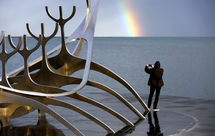 History
History
Iceland was settled during the Viking Age, within a short time span during the period 870-930 AD. It is estimated that 20-40.000 people moved here from Scandinavia (mainly Norway) and the British Isles. From 930 the country was ruled by a council of 12 chieftains from all of the country, the so-called Godi´s (Goðar). Nobody was made king, though, and this system worked well until civil war in the 13th century led to the downfall of the Free Republic. Iceland then came under Norwegian and later Danish rule and Copenhagen became the capital of Iceland for 500 years. The period 1300 - 1800 was a time of hardship and the population stayed below 50.000 people most of the time, due to natural catastrophes, famine and plagues. The 19th century saw enlightenment and the start of a struggle for independence which culminated with full independence from Denmark in 1944. A modern society with a high standard of living was developed throughout the 20th century but in the 21st century Icelanders have yet to learn how not to misstep themselves in the globalized world; the banking crisis in 2008 being a prime example of how things can go wrong.
Geology
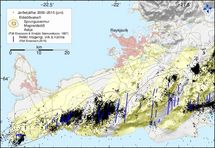 Being one of only two places on Earth where the rift zones running through Earth´s seafloor can be observed on land, Iceland displays a variety of unique geological phenomena. The rift zone runs from the southwestern tip through the country to the north, with transform faults located in SW Iceland and off the coast of N-Iceland. Volcanism is at present confined to the eastern branch of the neovolcanic zone. Rocks become progressively older farther away from the rift zone, with highest ages close to 15 million years found in the northwestern peninsula (Vestfirðir) and in Eastern Iceland. Glaciation has sculpted most of the country and in the central part, formations resulting from subglacial volcanism during the ice age are abundant. An excellent outline of the geology of Iceland by Þorvaldur Þórðarson can be downloaded.
Being one of only two places on Earth where the rift zones running through Earth´s seafloor can be observed on land, Iceland displays a variety of unique geological phenomena. The rift zone runs from the southwestern tip through the country to the north, with transform faults located in SW Iceland and off the coast of N-Iceland. Volcanism is at present confined to the eastern branch of the neovolcanic zone. Rocks become progressively older farther away from the rift zone, with highest ages close to 15 million years found in the northwestern peninsula (Vestfirðir) and in Eastern Iceland. Glaciation has sculpted most of the country and in the central part, formations resulting from subglacial volcanism during the ice age are abundant. An excellent outline of the geology of Iceland by Þorvaldur Þórðarson can be downloaded.
Natural hazards
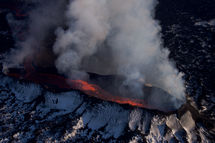 Natural hazards are abundant in Iceland: Volcanic eruptions, earthquakes, catastrophic floods from glaciers (jökulhlaups), Atlantic storms, coastal flooding, avalanches and debris flows. Research on these phenomena and steady monitoring using state-of-the art warning systems is actively being conducted by the Icelandic Meteorological Office and the Institute of Earth Sciences, University of Iceland. Within the past weeks, seismic rumblings have occurred in the subglacial volcano Katla, located beneath the Mýrdalsjökull ice cap. Moreover, conductivity of rivers flowing from the ice cap has been at a high level. Some misleading newspieces on these developments have appeared in the international press lately, indicating that signs of an imminent eruption are being observed. But the truth is that this is typical late summer behavior in Katla, probably related to summertime production of meltwater. A close watch will be kept on all monitoring systems, though, during fieldtrips in the region.
Natural hazards are abundant in Iceland: Volcanic eruptions, earthquakes, catastrophic floods from glaciers (jökulhlaups), Atlantic storms, coastal flooding, avalanches and debris flows. Research on these phenomena and steady monitoring using state-of-the art warning systems is actively being conducted by the Icelandic Meteorological Office and the Institute of Earth Sciences, University of Iceland. Within the past weeks, seismic rumblings have occurred in the subglacial volcano Katla, located beneath the Mýrdalsjökull ice cap. Moreover, conductivity of rivers flowing from the ice cap has been at a high level. Some misleading newspieces on these developments have appeared in the international press lately, indicating that signs of an imminent eruption are being observed. But the truth is that this is typical late summer behavior in Katla, probably related to summertime production of meltwater. A close watch will be kept on all monitoring systems, though, during fieldtrips in the region.
Advantages
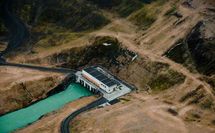 For centuries, glaciers and volcanoes created only difficulties for Icelanders but it can be said that during the 20th century the nation learned to turn these great forces of nature to society´s advantage: Part of the precipitation on Iceland falls as snow on the glaciers, is stored there as ice for hundreds of years and then released as glacial meltwater. Over the past 50 years, hydropower plants have been built on several of the glacial rivers and in total they now produce about 2000 MW of electricity. Some of the precipitation falling on the highlands, flows deep into the bedrock and comes into contact with hot rock at 2 - 3 km depth, within geothermal systems in volcanic zones. From these systems we now extract large amounts of energy in geothermal plants. Cold groundwater is heated in the plants and used for domestic heating and electricity is produced in turbines. The geothermal plants now produce about 27% of all the electricity used in Iceland.
For centuries, glaciers and volcanoes created only difficulties for Icelanders but it can be said that during the 20th century the nation learned to turn these great forces of nature to society´s advantage: Part of the precipitation on Iceland falls as snow on the glaciers, is stored there as ice for hundreds of years and then released as glacial meltwater. Over the past 50 years, hydropower plants have been built on several of the glacial rivers and in total they now produce about 2000 MW of electricity. Some of the precipitation falling on the highlands, flows deep into the bedrock and comes into contact with hot rock at 2 - 3 km depth, within geothermal systems in volcanic zones. From these systems we now extract large amounts of energy in geothermal plants. Cold groundwater is heated in the plants and used for domestic heating and electricity is produced in turbines. The geothermal plants now produce about 27% of all the electricity used in Iceland.
Sagas
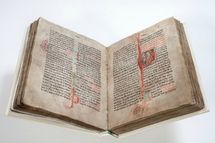 One cannot understand the Icelandic psyche without first becoming familiar with the 13th century Sagas, which mainly detail people and events during the 10th century. In medieval times Iceland also became a storehouse of information on the old Nordic religion and on Nordic prehistory. Large chronicles were written on Norwegian, Danish and Swedish kings, on events in the British Isles and on Viking age travels as far as to the Black Sea in the east and to Greenland and Newfoundland in the west. These 12th and 13th century works of history and literature have been translated into many different languages and are available in Reykjavík bookstores, as well as on the web. Exhibitions on manuscripts change from year to year but you can check out what is on display in the building Árnagarður, next to the University's Main Building.
One cannot understand the Icelandic psyche without first becoming familiar with the 13th century Sagas, which mainly detail people and events during the 10th century. In medieval times Iceland also became a storehouse of information on the old Nordic religion and on Nordic prehistory. Large chronicles were written on Norwegian, Danish and Swedish kings, on events in the British Isles and on Viking age travels as far as to the Black Sea in the east and to Greenland and Newfoundland in the west. These 12th and 13th century works of history and literature have been translated into many different languages and are available in Reykjavík bookstores, as well as on the web. Exhibitions on manuscripts change from year to year but you can check out what is on display in the building Árnagarður, next to the University's Main Building.



